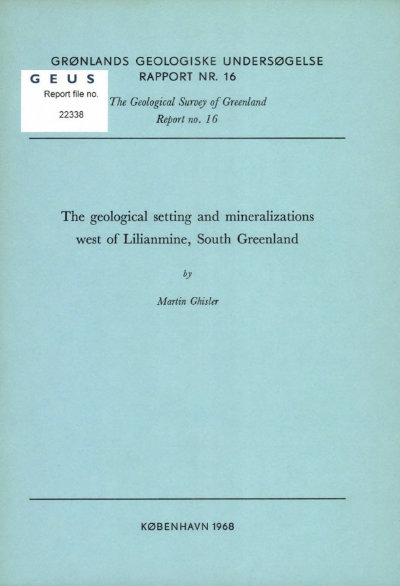The geological setting and mineralizations west of Lilianmine, South Greenland
DOI:
https://doi.org/10.34194/rapggu.v16.7185Abstract
The coastal strip of green schists at the south side of Kobberminebugt consists of a sequence of alternating meta-volcanic rocks and meta-sediments. Uralite porphyrite and subordinate plagioclase porphyrite represent the volcanic component of the geosynclinal deposits, whereas no meta-sediments have been recognized with certainty in the area under consideration. Pillow structures indicate the extrusive origin of the basic lavaflows and its original porphyritic texture is well-preserved at one locality. Different grades of pressure and metamorphism during the Ketilidian orogeny have elsewhere given rise to a transitional series from uralite porphyrite to schistose greenstone. A small composite intrusion with sharp contacts and a characteristic joint system is regarded to be an appinitic suite of Sanerutian age. A monzonitic magma was intruded into the centre of a gabbro body, a probable early derivative of which is represented by a hornblendite. A ringdyke of quartz dioritic composition intruded the basic rocks, the age relation to the monzonite remaining uncertain. Some irregular intrusive bodies of pink felsite, which in some places have the character of quartz porphyries, are based on the dolerite chronology, shown to be of Gardar age. A swarm of pegmatite dykes extends from the biotite granite of the Nunarssuit intrusive complex into the green schists. The subhorizontal pegmatites are interesting because of their rare minerals such as beryl, amazonestone, molybdenite, and aegirine with pseudomorphs of hematite in large crystals. Copper sulphides occur in the pegmatites, but are most important in the hydrothermal mineralizations along faults and shear zones, joints and fracture fillings. Bigger concentrations of ore have only been found in two places, but they are not of economic importance. Geophysical measurements with a magnetometer have shown anomalies in the green schists, which mainly are regarded to be due to different grades of compaction of the metamorphosed magnetite-bearing volcanic rocks. Geochemical analyses have been made on 4 rock samples, the results of which in relation with the distribution pattern of the mineralizations in the field suggest, that the copper necessary for the formation of the ores has been extracted from the green schists by hydrothermal activity, in this area related with the intrusion of the biotite granite. Trace element determinations on 2 botanical samples were made to test the possibilities for applicating two common plants in the region in geo-botanical prospecting.
Downloads
Published
Issue
Section
License
This article is distributed under a CC-BY 4.0 licence, permitting free redistribution and reproduction for any purpose, even commercial, provided proper citation of the original work. Author(s) retain copyright over the article contents.


